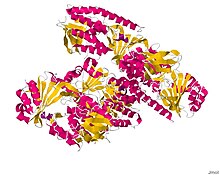
Back أكسيجيناز أحادية Arabic Monooksigenaza BS Monooxigenasa Catalan Monooxigenasa Spanish منواکسیژناز Persian Monooxygénase French Monooksigenase ID 일산소화효소 Korean Monooksigenase Malay Mono-oxygenase Dutch
| Monooxygenase | |||||||||
|---|---|---|---|---|---|---|---|---|---|
 Structure of the TetX monooxygenase in complex with the substrate 7-Iodtetracycline.[1] | |||||||||
| Identifiers | |||||||||
| Symbol | FAD_binding_3 | ||||||||
| Pfam | PF01494 | ||||||||
| InterPro | IPR002938 | ||||||||
| SCOP2 | 2phh / SCOPe / SUPFAM | ||||||||
| |||||||||
Monooxygenases are enzymes that incorporate one hydroxyl group (−OH) into substrates in many metabolic pathways. In this reaction, the two atoms of dioxygen are reduced to one hydroxyl group and one H2O molecule by the concomitant oxidation of NAD(P)H.[2][3] One important subset of the monooxygenases, the cytochrome P450 omega hydroxylases, is used by cells to metabolize arachidonic acid (i.e. eicosatetraenoic acid) to the cell signaling molecules, 20-hydroxyeicosatetraenoic acid or to reduce or totally inactivate the activate signaling molecules for example by hydroxylating leukotriene B4 to 20-hydroxy-leukotriene B5, 5-hydroxyeicosatetraenoic acid to 5,20-dihydroxyeicosatetraenoic acid, 5-oxo-eicosatetraenoic acid to 5-oxo-20-hydroxyeicosatetraenoic acid, 12-hydroxyeicosatetraenoic acid to 12,20-dihydroxyeicosatetraenoic acid, and epoxyeicosatrienoic acids to 20-hydroxy-epoxyeicosatrienoic acids.
- ^ PDB: 2Y6Q; Volkers G, Palm GJ, Weiss MS, Wright GD, Hinrichs W (April 2011). "Structural basis for a new tetracycline resistance mechanism relying on the TetX monooxygenase". FEBS Lett. 585 (7): 1061–6. doi:10.1016/j.febslet.2011.03.012. PMID 21402075. S2CID 26967337.
- ^ Harayama S, Kok M, Neidle EL (1992). "Functional and evolutionary relationships among diverse oxygenases". Annu. Rev. Microbiol. 46: 565–601. doi:10.1146/annurev.mi.46.100192.003025. PMID 1444267.
- ^ Schreuder HA, van Berkel WJ, Eppink MH, Bunthol C (1999). "Phe161 and Arg166 variants of p-hydroxybenzoate hydroxylase. Implications for NADPH recognition and structural stability". FEBS Lett. 443 (3): 251–255. doi:10.1016/S0014-5793(98)01726-8. PMID 10025942. S2CID 21305517.